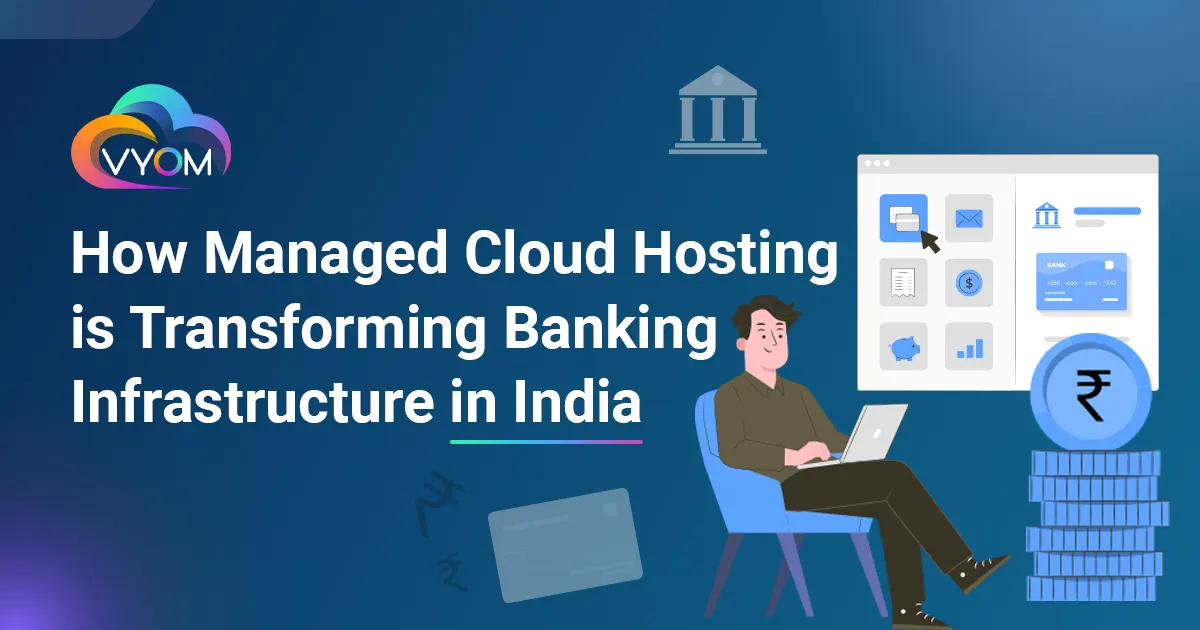Digitization and changing client expectations have transformed India’s banking sector. As UPI, mobile banking apps, AI-driven financial services, and secure data environments increase, traditional banking infrastructure is becoming obsolete. In this setting, managed cloud hosting has revolutionized scalability, agility, and security for current financial needs.
Managed cloud hosting is helping Indian banks adopt cloud-native, resilient models by providing seamless digital transactions and real-time fraud detection. This strategic and technological change lets institutions focus on innovation and customer experience while cloud professionals manage infrastructure.
Knowing Managed Cloud Hosting
Managed cloud hosting involves banks outsourcing cloud infrastructure management to specialists. They handle server maintenance, software updates, cybersecurity, compliance, backup, and disaster recovery. Financial organizations can use high-performance infrastructure without daily technical administration.
This differs from unmanaged or self-hosted cloud environments where the organization manages everything. Banks receive end-to-end support in the managed model to execute important financial applications safely.
Indian Banking’s Digital Transformation
Digital technology are transforming India’s banking business. Digital India, Jan Dhan Yojana, and Aadhaar and UPI use have made digital banking the default for millions.
Banks must provide consistent performance and seamless services across mobile applications, websites, ATMs, and call centers in this fast-changing sector. Latency and downtime are unacceptable. Managed cloud hosting lets banks meet client expectations without infrastructure bottlenecks by ensuring near-perfect uptime, faster processing, and scalable computing capability.
Why Indian Banks Are Using Managed Cloud Hosting
Indian banks are moving to managed cloud hosting due to the surge in digital transactions. Legacy infrastructure cannot handle billions of UPI payments, real-time settlements, and app-based banking. Managed cloud infrastructures let banks conduct transactions quickly and securely while increasing resources.
Another major factor is compliance. The RBI requires data localization, audit trails, and strong cybersecurity. Indian data center managed cloud providers offer pre-configured, regulation-ready solutions to simplify compliance.
Cybersecurity also matters. With banking services growing online, cyberattacks are at an all-time high. With 24/7 monitoring, intrusion detection, and data encryption, managed hosting companies reduce these risks.
Due to the need for uninterrupted services, uptime and disaster recovery are prioritized. Redundancy, backup automation, and failover assure company continuity with managed cloud hosting.
Finally, cost efficiency is gaining importance. Maintaining old IT systems needs significant capital and devoted staff. Flexible pricing models allow banks to turn capital expenses into predictable operations spending with managed cloud solutions.
Managed cloud hosting offers significant benefits for banking infrastructure, including scalability. Banks can automatically enhance resources for festivals, end-of-month settlements, and IPO launches. Services remain uninterrupted at peak load due to this elasticity.
Compliance preparedness is another benefit. Managed cloud hosting environments often comply with data localization regulations, RBI cybersecurity standards, and financial audit methods. This spares banks the hassle of implementing regulatory criteria.
Rapid market entry is essential in a competitive financial environment. Managed cloud environments let banks swiftly test, implement, and iterate new services. The cloud speeds up and reduces resource requirements for innovations like UPI, voice assistants, and AI-driven credit scoring.
Security is essential in banking. Managed cloud platforms have real-time threat monitoring, end-to-end encryption, and role-based access controls. Security teams at providers often aggressively patch holes and strengthen protections.
Another important part is disaster recovery. After a server crash or hack, managed cloud systems can restore data and operations quickly. This resilience minimizes consumer disturbance and protects the bank’s brand.
Managed cloud hosting saves money. Banks no longer require pricey hardware or massive IT teams to manage infrastructure. They can instead subscribe to a managed service with clear prices and SLAs.
Also improved is customer experience. With faster response times, increased uptime, and dependable service delivery, users can access their accounts, make payments, and complete financial chores without interruption. Being reliable fosters trust and loyalty.
Case studies of Indian adoption
At a Tier IV data center, a large Indian state-owned bank moved its key banking activities from on-premise servers to a managed cloud. Frequent service disruptions and challenges expanding digital services to rural branches prompted this choice. The bank has 99.98% uptime one year after transfer. IT infrastructure costs fell by 30% and complaint resolution times fell by 40%. The move increased service availability in urban and rural branches, allowing the bank to provide a consistent customer experience.
Another significant private sector bank focused on a mobile-first strategy teamed with Bharat Data Center to accelerate its digital expansion. Latency and operational constraints plagued the bank as UPI and chatbot-based banking demand increased. Bharat Data Center’s managed hosting infrastructure in India allowed the bank to achieve sub-second UPI response times, real-time fraud monitoring, and 45% lower latency for Tier 2 and Tier 3 users. Local support and compliance-oriented hosting from Bharat Data Center helped secure and streamline access across India.
To meet consumer demands, a fintech loan startup used managed cloud hosting. The firm saw traffic and loan applications surge during festivals and marketing initiatives. The firm reduced loan application processing times from three hours to twenty-five minutes with a hybrid managed cloud configuration housed across Indian data zones. They increased loan disbursals in a quarter without adding backend teams. Smooth integration with Aadhaar and GST databases sped up KYC and credit checks. Bharat Data Centre supports NBFCs and allows size and performance without compromise.
The Indian financial ecosystem relies heavily on trust and security. Customers in Bharat’s Tier 2 and Tier 3 cities demand their banks to be reliable, secure, and always available. Downtime costs money and hurts reputation, which banks cannot afford in a competitive market.
Trust and comfort come from Indian managed cloud services. The infrastructure is tailored to India’s connection, bandwidth, and regulations. In-country data storage keeps sensitive data in India, meeting legal and public data protection obligations.
Vyom Cloud offers regionally distributed data centers, real-time support in Indian time zones, and BFSI compliance setups. Indian banks can trust their cloud journey and guarantee uninterrupted and safe service.
Forecast: Indian Banking’s Cloud-First Future
Managed cloud hosting popularity is just beginning. Core financial systems will soon be cloud-native and scalable with microservices and APIs. Open banking frameworks will enable banks to partner with fintechs and startups in real time to deliver plug-and-play financial services.
Cloud infrastructure will fuel AI-powered fraud protection, customer personalization, and predictive analytics. Edge computing and low-latency cloud zones will expand rural Indian digital banking.
Additionally, the RBI and other regulators are increasingly supporting cloud models that improve cybersecurity and operational resilience. As frameworks evolve, institutions can adopt complex designs without regulatory friction.
Managed cloud hosting will power Indian financial innovation. It is building a truly inclusive, responsive, and safe financial system for all Indians, from metros to villages.
Conclusion
Indian financial infrastructure is being transformed by managed cloud hosting. It provides modern banks with security, compliance, scalability, and innovation in a cost-effective and well-managed environment.
Managed cloud solutions give legacy public banks modernizing their systems and fintech startups increasing their user base the stability and flexibility they need to succeed in today’s financial world. Digital banking excellence is easier than ever with trustworthy partners providing regional infrastructure and services adapted to Indian regulations and reality.
The foundation must be sturdy as India moves toward a digital economy. Managed cloud hosting provides performance, compliance, and future readiness.
FAQs: Managed Cloud Hosting in Indian Banking
1. What is managed cloud hosting in the context of banking?
Managed cloud hosting allows banks to outsource IT infrastructure management—such as servers, updates, backups, and cybersecurity—to cloud experts, ensuring security, uptime, and regulatory compliance.
#ManagedCloudHosting #BankingCloud #CloudInfrastructure
2. How is managed cloud hosting different from self-managed cloud?
In managed hosting, the provider handles all technical aspects, including maintenance, monitoring, and compliance. Self-managed cloud puts full responsibility on the bank’s internal team.
#CloudManagement #SelfManagedVsManaged #CloudHostingIndia
3. Why are Indian banks adopting managed cloud hosting?
To handle massive digital transaction volumes, meet RBI compliance, improve uptime, secure data, and lower infrastructure costs—especially for UPI and mobile-first services.
#DigitalBankingIndia #CloudForBanks #UPIScalability
4. How does managed cloud hosting help with RBI compliance?
Managed hosting providers offer regulation-ready infrastructure, including data localization, audit trails, encryption, and cybersecurity features mandated by the RBI.
#RBICompliance #DataLocalization #SecureCloud
5. What are the cybersecurity benefits of managed cloud hosting for banks?
Banks benefit from 24/7 monitoring, intrusion detection systems, data encryption, patch management, and security audits—all handled by professionals.
#BankingSecurity #CloudCybersecurity #SecureHostingIndia
6. How does managed cloud hosting improve customer experience in banking?
It ensures faster response times, minimal downtime, real-time transactions, and consistent service across branches and platforms like UPI, apps, and ATMs.
#CustomerExperience #DigitalBanking #HighAvailability
7. Can managed cloud hosting support peak banking loads like IPOs or festivals?
Yes, it offers elastic scalability—resources automatically scale up during high-traffic events such as IPOs, salary days, or festive seasons.
#ScalableCloud #PeakLoadHandling #ElasticInfrastructure
8. Is managed cloud hosting cost-effective for Indian banks?
Yes. It reduces capital expenses by replacing hardware and IT manpower with predictable, subscription-based models.
#CloudCostSavings #BankingOps #CapexToOpex
9. How does managed cloud hosting support disaster recovery in banking?
It enables automated backups, multi-zone failovers, and quick recovery solutions to ensure business continuity in case of data loss or downtime.
#DisasterRecovery #BusinessContinuity #CloudBackup
10. What role does Bharat Data Centre play in this transformation?
Bharat Data Centre offers compliant, locally hosted, secure managed cloud infrastructure with low latency, supporting Tier 2/3 banks and fintechs with regional support.
#VyomCLoud #IndianCloudProvider #BankingInnovation
11. How are fintech startups using managed cloud hosting?
Fintechs use it to process large volumes of data quickly, scale operations efficiently, and integrate with Aadhaar/GST databases for fast KYC and lending.
#FintechIndia #StartupCloud #KYCIntegration
12. What is the future of managed cloud hosting in Indian banking?
It will support AI-powered personalization, open banking, edge computing, and microservices, enabling real-time innovations across urban and rural India.
#FutureOfBanking #OpenBanking #AIinBanking #EdgeCloud
Tagged Managed Cloud Hosting Indian Banking Infrastructure Digital Banking Transformation Cloud Hosting for Banks RBI Compliance Data Localization Banking Cybersecurity Cloud Scalability Disaster Recovery Solutions UPI Transactions Fintech Cloud Adoption Customer Experience in Banking BFSI Cloud Solutions Bharat Data Centre Core Banking on Cloud AI in Financial Services Mobile-First Banking Hybrid Cloud for Banks Banking IT Modernization Cloud-Native Banking Open Banking India Edge Computing in Finance Banking Innovation Indian Cloud Providers Financial Digital Infrastructure Cost Optimization in Banking IT Cloud Compliance for Banks Banking Sector Technology Trends Secure Cloud Hosting India

